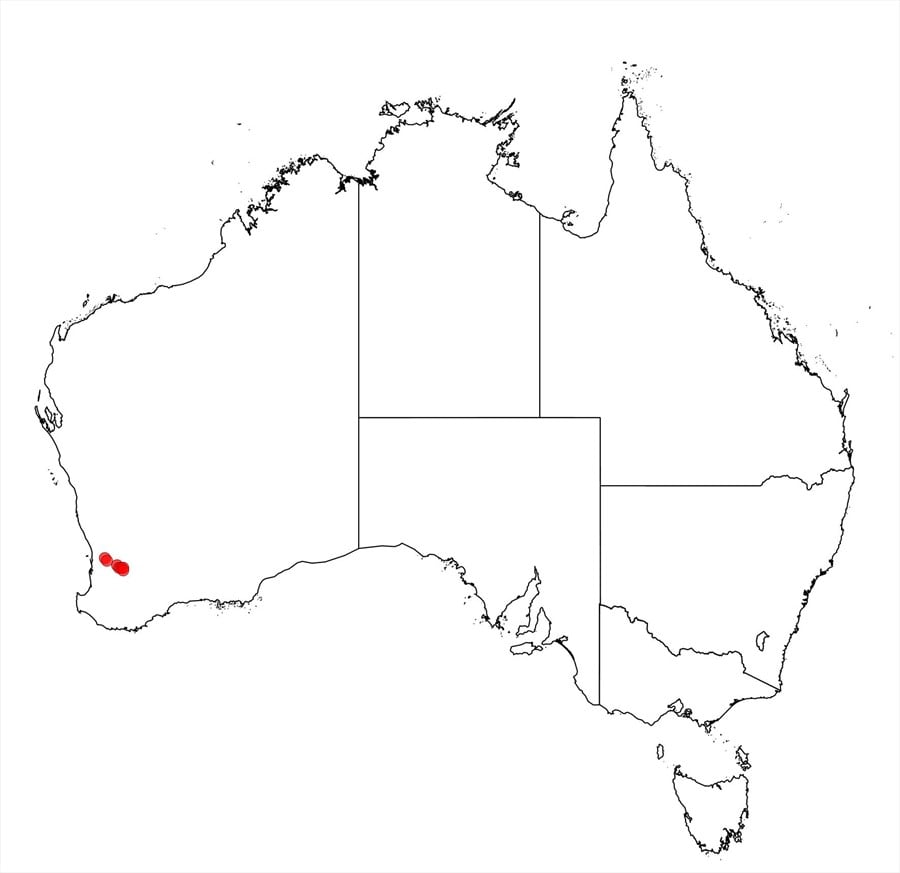Acacia adjutrices Maslin
WATTLE
Acacias of Australia
Common Name
Convivial Wattle
Family
Fabaceae
Distribution
Occurs in a few, disjunct populations near Pingelly and Brookton in the south-central wheatbelt region of south-western W.A.
Description
Multi-stemmed sub-shrub normally 0.3–0.7 m tall. Stems slender, glabrous or sometimes sparsely hairy. Stipules 0.5–1 mm long. Bipinnate leaves absent or rarely a few at base of stems; pinnae 1 pair, 5–12 (–15) mm long; pinnules 2–3 (–4) pairs, normally ±lanceolate, 5–12 (–20) mm long, 2–4 (–7) mm wide, flat, sub-glaucous, glabrous or with sparse, minute, appressed hairs on margins. Phyllodes often resembling the stems, mostly linear, flat except sometimes ±quadrangular when very narrow, 50–150 (–180) mm long except shorter (mostly 15–40 mm) where inflorescences occur, normally 0.8–2 mm wide, ascending to erect, glabrous; midrib prominent; gland absent. Inflorescences simple, initiated on new shoots within axils of juvenile phyllodes, sometimes a few short axillary racemes or forming false terminal racemes; peduncles 4–10 (–12) mm long, sparsely to densely hirtellous; heads globular, 11–19-flowered, golden. Flowers 5-merous; sepals united; petals 1-nerved. Pods linear to narrowly oblong, 30–60 mm long, 4–4.5 mm wide, crustaceous, ±straight, greyish brown, often faintly pruinose, glabrous, margins thick and yellow. Seeds mostly longitudinal and obloid, obliquely truncate on edge adjacent to aril, 3–4 mm long, shiny, black, arillate.
Phenology
Flowers July.–Aug.; mature pods late Nov.–mid-Dec.
Habitat
Grows in loam or clay on laterite hills in sandplain scrub, normally in association with Eucalyptus wandoo.
Specimens
W.A.: Tutanning Reserve, A.S.George 7371 (PERTH); Wandoo Conservation Park, D.Lamont, Aug. 1988 (PERTH); 5 km W of Brookton, P.C.Williams 136 (PERTH).
Notes
Formerly treated as a subspecies of A. insolita which is readily distinguished by having persistent bipinnate foliage that extends from the base of the stems to the upper fertile region where inflorescences and phyllodes are produced. The leaves of A. insolita have longer pinnae with more numerous leaflets; it also has wider pods with normally transverse to oblique seeds that are seated in wider (mostly 4–5 mm) depressions that are ±square, or if oblong, are transversely oriented (these depressions are c. 3 mm wide and longitudinally oriented in A. adjutrices). Acacia adjutrices superficially resembles A. flagelliformis which has consistently racemose inflorescences (racemes enclosed when young by prominent brown bracts), 6–9-flowered heads, nerveless petals and no bracteoles.
Conservation
Acacia adjutrices is listed as Priority Three under Department of Parks and Wildlife Conservation Codes for Western Australian Flora.
FOA Reference
Data derived from Flora of Australia Volumes 11A (2001), 11B (2001) and 12 (1998), products of ABRS, ©Commonwealth of Australia
Author
B.R.Maslin
This identification key and fact sheets are available as a mobile application:
URL: https://apps.lucidcentral.org/wattle/
© Copyright 2018. All rights reserved.






